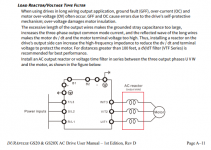synchro
Senior Member
- Location
- Chicago, IL
- Occupation
- EE
A dV/dt filter such as the ones at the link below from Hammond incorporate resistors that are shunted across a reactor to dampen oscillations that may occur when the VFD output is switching and then be conducted to the motor. And the reactor slows the risetimes of the switching waveforms to minimize problems with reflected voltages that can increase the peak voltage at the motor.
https://americas.hammondpowersolutions.com/en/products/control-automation/dv-dt-filters
https://americas.hammondpowersolutions.com/en/products/control-automation/dv-dt-filters

